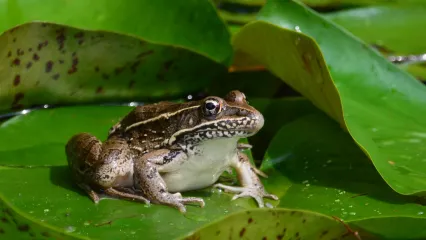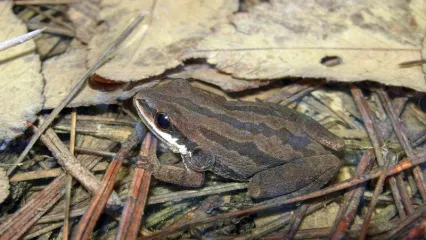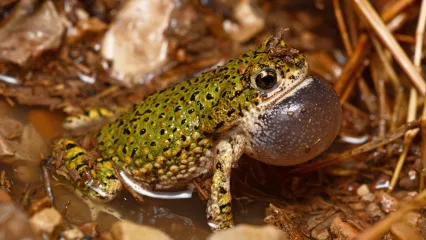
Description
Plains leopard frogs have smooth skin can be brown or green. The most distinguishing characteristic is the large brown spots scattered over the back and sides (hence the name “leopard frog”). These frogs typically have one brown spot on the top of the snout. The upper lip has a prominent white stripe. Another distinguishing characteristic is the light tan or yellow dorsolateral ridges on the back. In this species, the ridges have a small break near the hind legs, producing a small section at the end of the ridge that is offset. The large hind legs have dark brown bands. The belly and undersides of the arms and legs are white.
Tadpoles are brown to gray with mottling on the body and fins. The dorsal fin is high and originates anterior to the tail-body junction. Tadpoles can attain a large size, up to 3 inches, prior to metamorphosis.
Size
Plains leopard frogs are typically 2 to 3 ¾ inches in body length. Females are considerably larger than males. Newly transformed froglets are about 1 ½ inches in body length.
Habitat
Plains leopard frogs occur throughout the western one-third of Oklahoma and in adjacent parts of Texas, New Mexico, and Colorado, and north into the Central Plains states. They inhabit ponds and marshy areas.
Life Cycle
Plains leopard frogs typically have two breeding peaks; one in early spring, usually in March, and the other in late summer, usually in September, although they may breed after heavy rains in most months. The eggs are deposited in a large ball or round clump; each mass can contain several thousand eggs.
The calls of plains leopard frogs are usually heard at night when conditions are suitable. After heavy rains, they may call during the day. The low call is a series of chuckling notes, interspersed with other notes that sound like rubbing fingers over a balloon.
Plains leopard frogs feed on insects, including beetles and dragonflies.
How To Observe
These frogs can sometimes be seen during the day along the margins of ponds. They often sit in weedy areas, so careful searching is required to locate them. Frequently they are seen just as they are diving into the water. When they jump, the do not emit a short squeal as do bullfrogs. When frightened, they submerge on the bottom of the pond and do not emerge for quite some time. At night, they can be seen with the aid of a flashlight or headlamp along pond shorelines.
(This profile was created by Dr. Laurie Vitt as part of a partnership between the Wildlife Department and the Sam Noble Oklahoma Museum of Natural History. It was funded as part of a larger grant to survey and inventory amphibians and reptiles of the Wildlife Management Areas of Oklahoma: T-35-P-1.)

